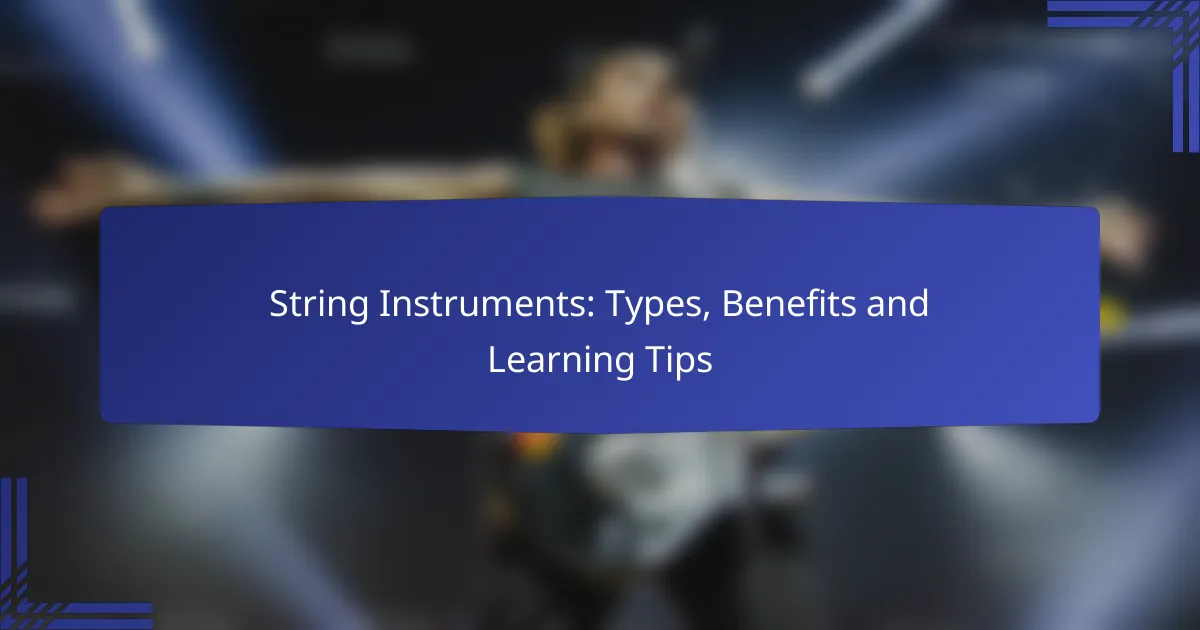String instruments encompass a diverse range of types, such as violins, guitars, and cellos, each with its own unique sound and playing style. Learning to play these instruments not only enhances cognitive abilities and fosters emotional expression but also promotes social interaction and personal discipline. When selecting a string instrument, it’s important to consider your skill level, musical preferences, and comfort to ensure a rewarding experience.

What types of string instruments are available?
String instruments come in various types, each with unique characteristics and playing techniques. Common types include violins, guitars, cellos, double basses, and harps, each offering distinct sounds and uses in different musical genres.
Violins
Violins are small, four-string instruments known for their high pitch and expressive range. They are played with a bow and are essential in classical music, folk, and even modern genres like jazz. Beginners should focus on proper posture and bowing technique to develop a solid foundation.
When selecting a violin, consider factors like size, material, and brand. Full-sized violins are typically 14 inches in body length, while smaller sizes are available for younger players. Renting a violin can be a cost-effective option for beginners.
Guitars
Guitars are versatile string instruments with six strings, widely used in many music styles, from rock to classical. They can be acoustic or electric, each offering different sound qualities. Beginners should practice basic chords and strumming patterns to build their skills.
Choosing a guitar involves deciding between acoustic and electric types. Acoustic guitars are great for portability and simplicity, while electric guitars require an amplifier for sound. A good starter guitar typically costs between $100 and $500.
Cellos
Cellos are larger string instruments with a rich, deep tone, played while seated. They have four strings and are commonly used in orchestras and chamber music. Learning to play the cello involves mastering finger placement and bowing techniques, which can take time.
Cellos come in various sizes, with full-sized instruments being around 4 feet long. Beginners may benefit from renting a cello, which can range from $50 to $150 per month, depending on quality and location.
Double Basses
Double basses are the largest string instruments, providing the lowest pitches in orchestras. They have four strings and can be played with a bow or plucked. Due to their size, learning to play the double bass requires physical strength and proper technique.
When selecting a double bass, consider the size and weight, as they can be cumbersome. Full-sized double basses are typically around 6 feet tall, while smaller models are available for younger players. Renting is often a practical choice for beginners.
Harp
Harps are unique string instruments with a triangular frame and numerous strings, producing a soft, ethereal sound. They can be played by plucking the strings with fingers and are often featured in classical and folk music. Beginners should focus on hand positioning and basic scales.
Harp sizes vary, with pedal harps being larger and more complex than lever harps. A good quality lever harp can cost between $1,000 and $3,000, while pedal harps can be significantly more expensive. Renting is a viable option for those just starting out.

What are the benefits of playing string instruments?
Playing string instruments offers numerous benefits, including cognitive enhancement, emotional expression, social interaction, and the development of discipline. Engaging with these instruments can lead to improved mental skills and personal growth.
Improves cognitive skills
Learning to play string instruments significantly boosts cognitive abilities such as memory, attention, and problem-solving. The process of reading music and coordinating finger movements stimulates brain activity, enhancing overall mental function.
For example, studies suggest that musicians often perform better in tasks requiring spatial-temporal skills, which are crucial for mathematics and science. Regular practice can lead to long-term improvements in these areas.
Enhances emotional expression
String instruments allow players to convey a wide range of emotions through music, fostering emotional intelligence. This form of expression can be therapeutic, helping individuals process feelings and communicate experiences that may be difficult to articulate verbally.
For instance, playing a piece that resonates emotionally can provide a sense of relief and connection, making music a powerful outlet for personal expression.
Boosts social interaction
Participating in group music activities, such as orchestras or ensembles, promotes social skills and teamwork. Collaborating with others to create music fosters connections and builds friendships among musicians.
Moreover, attending concerts or music classes can enhance community engagement, providing opportunities to meet others who share similar interests in string instruments.
Increases discipline and patience
Mastering a string instrument requires consistent practice and dedication, which cultivates discipline and patience. Setting goals for progress and adhering to a practice schedule helps develop a strong work ethic.
For beginners, it is essential to practice regularly, even for short periods, to build skills gradually. This commitment not only improves musical abilities but also translates to other areas of life, reinforcing the value of perseverance.

How to choose the right string instrument?
Choosing the right string instrument involves considering your skill level, preferred music genre, and physical comfort. Each factor plays a crucial role in ensuring a satisfying and enjoyable playing experience.
Consider skill level
Your skill level is a primary factor in selecting a string instrument. Beginners may find it easier to start with instruments like the violin or ukulele, while more advanced players might prefer the complexity of a cello or double bass.
It’s important to assess your current abilities and how much time you can dedicate to practice. Instruments with a steeper learning curve may require more commitment and patience, so choose one that aligns with your readiness to learn.
Evaluate music genre
The music genre you wish to play significantly influences your choice of string instrument. For example, classical music often features violins and cellos, while folk and pop music may lean towards guitars or mandolins.
Consider what styles resonate with you and what you enjoy listening to. This alignment will keep you motivated and engaged in your practice, making the learning process more enjoyable.
Assess physical comfort
Physical comfort is essential when selecting a string instrument. Instruments vary in size and weight, which can affect playability, especially for younger or smaller players. For instance, a full-sized cello may be cumbersome for a child, while a half-sized option could be more suitable.
Try out different instruments to see how they feel in your hands and against your body. Pay attention to how long you can comfortably play without strain, as this will impact your practice sessions and overall enjoyment.

What are effective learning tips for string instruments?
Effective learning tips for string instruments include regular practice, utilizing online resources, and engaging with local music communities. These strategies can enhance your skills, provide support, and make learning more enjoyable.
Practice regularly
Consistent practice is crucial for mastering string instruments. Aim for at least 30 minutes a day, gradually increasing your practice time as you progress. This routine helps build muscle memory and improves overall technique.
Focus on specific skills during each session, such as scales, finger positioning, or bowing techniques. Breaking down your practice into manageable segments can make it less overwhelming and more productive.
Utilize online tutorials
Online tutorials offer a wealth of resources for learning string instruments. Platforms like YouTube and dedicated music education websites provide video lessons, sheet music, and practice exercises that cater to various skill levels.
Consider following structured courses that guide you through the learning process. Many of these resources are free or available at a low cost, making them accessible for learners on a budget.
Join local music groups
Joining local music groups can significantly enhance your learning experience. Look for community orchestras, string quartets, or music clubs where you can play with others and receive feedback on your performance.
Participating in group activities not only fosters a sense of camaraderie but also exposes you to different playing styles and techniques. This interaction can motivate you to practice more and improve your skills faster.

What are the best brands for string instruments?
The best brands for string instruments vary by type, with each offering unique qualities and craftsmanship. Notable brands include Yamaha for guitars, Stradivarius for violins, and Eastman for cellos, each recognized for their excellence in sound and build quality.
Yamaha for guitars
Yamaha is renowned for producing high-quality guitars suitable for beginners and professionals alike. Their instruments are known for their durability, excellent sound quality, and affordability, making them a popular choice among musicians.
When selecting a Yamaha guitar, consider the model that best fits your playing style. For instance, the Yamaha FG series is excellent for acoustic players, while the Pacifica series caters to electric guitarists. Both lines offer a variety of price points, typically ranging from a few hundred to over a thousand USD.
Stradivarius for violins
Stradivarius violins are considered some of the finest string instruments ever made, known for their exceptional sound and craftsmanship. Crafted by Antonio Stradivari in the late 17th and early 18th centuries, these violins are highly sought after and often fetch millions at auctions.
Owning a Stradivarius is a significant investment, typically reserved for professional musicians or collectors. If you’re looking for a quality violin without the Stradivarius price tag, consider modern makers who replicate the craftsmanship and sound characteristics, often priced in the low thousands to tens of thousands of USD.
Eastman for cellos
Eastman cellos are celebrated for their rich tone and affordability, making them a favorite among students and amateur players. The brand offers a range of cellos that cater to different skill levels, from beginner to advanced.
When choosing an Eastman cello, pay attention to the size and model that fits your needs. Prices generally range from around 1,000 to 5,000 USD, depending on the quality and craftsmanship. It’s advisable to try out several models to find the one that resonates best with your playing style.
